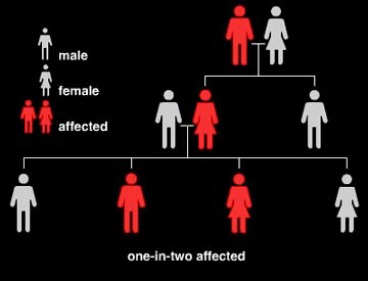How is Achondroplasia Inherited?

People with achondroplasia may pass on the condition to their children. The condition is autosomal dominant pattern. If one parent is affected, each child has a one-in-two chance of having achondroplasia, and a one-in-two chance of being average height. Those born with achondroplasia may pass the condition on to their own children, while those of average height will not.
The condition occurs in 1 in 15,000 to 40,000 newborns.
Mutations in the FGFR3 gene cause achondroplasia.The FGFR3 gene provides instructions for making a protein that is involved in the development and maintenance of bone and brain tissue. This protein limits the formation of bone from cartilage (ossification), particularly in the long bones=. Two specific mutations in the FGFR3 gene are responsible for almost all cases of achondroplasia. Researchers believe that these mutations cause the protein to be overly active, which interferes with skeletal development and leads to the disturbances in bone growth seen with this disorder.
The condition occurs in 1 in 15,000 to 40,000 newborns.
Mutations in the FGFR3 gene cause achondroplasia.The FGFR3 gene provides instructions for making a protein that is involved in the development and maintenance of bone and brain tissue. This protein limits the formation of bone from cartilage (ossification), particularly in the long bones=. Two specific mutations in the FGFR3 gene are responsible for almost all cases of achondroplasia. Researchers believe that these mutations cause the protein to be overly active, which interferes with skeletal development and leads to the disturbances in bone growth seen with this disorder.
